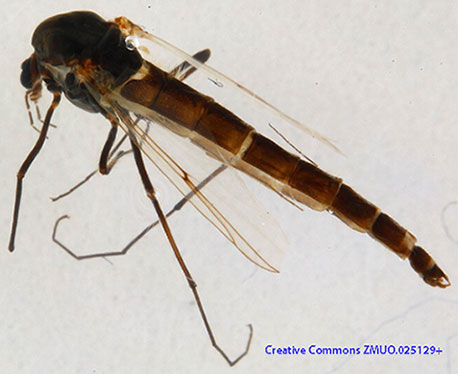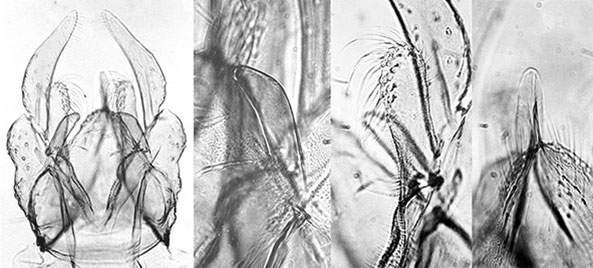Species u. C. species u.Near C. hyperboreus, C. aberratus or C. sororius and C. sp. 2u.In BOLD Bin: : BOLD:AAI4297
as unnamed species.Adult:
Adults and rearings of this species are in the Sublette Collection, now in the Museum of the University of Minnesota, St Paul, MN. Information on the male genitalia can be given from that material (see below).Male: Some information can be noted from photographs in the BOLD database:
 Wing length about 4.2-4.8 mm, VR about 0.86-0.97. Wing length about 4.2-4.8 mm, VR about 0.86-0.97.
Thorax dark brown, vittae, scutellum, postnotum, sternoplueron, legs, etc., blackish. Abdomen dark brown with a narrow pale band distal on segmentes VI and VII, sometime very narrow on preceding segments.
Approximate leg proportions (micron)
| Fe
| Ti
| Ta1
| Ta2
| Ta3
| PI
| 1615
| 1530
| -
| -
| -
| PII
| 1580
| 1500
| 1000
| 630
| 475
| PIII
| 1775
| 2000
| 1260
| 940
| 645
| -
| Ta4
| Ta5
| LR
| F/T
| BRTi
| PI
| -
| -
| -
| 1.05
| -
| PII
| 315
| 210
| 0.63
| 1.03-1.05
| -
| PIII
| 410
| 290
| 0.78
| 0.89
| -
| 
Male genitalia of Chironomus species u (in order, left to right) hypopygium, superior volsella, inferior volsella, anal point .
Superior volsella most similar to D(d) of Strenzke (1959). Setae of inferior volsella simple.
No, or only 1 or 2, median setae on tergite 9. Gonostylus narrowing relatively gently from about halfway.Female: - Wing length about 5 mm, VR about 0.95. Generally dark color, vittae, scutellum and postnotum and sternoplueron blackish. Abdominal sternites brown with yellowish posterior band. Photos suggest femurs are lighter brown. Pupa: Cephalic tubercles about 1.3 times longer than wide. Caudolateral spurs of segment VIII with about 3 (1-4) spines. Swim fin with about 62 taeniae in a double row on each side. Fourth instar larva a medium size plumosus-type (female 12.8-15.9 mm); lateral projections about 305 (200-440) µm; anterior ventral tubules 2.0 (1.10-2.48) mm, posterior 2.15 (1.30-2.13) mm, posterior pair generally longer. Anal tubules about 442 (405-500) µm (dors), 359 (359-600) µm (vent) and 2-3 times longer than wide with dorsal pair relatively longer (2.3-3.1 times) than the ventral pair (1.9-2.6 times).
Gular region generally dark on posterior third to half, often more at outer edges, and in rare cases reduced to a "V"; slightly dark to dark frontoclypeus, often just a stripe.
Mentum (Fig. c) with relatively rounded teeth; c1 tooth with short sides sloping outwards, c2 teeth moderately seperated (possibly type III but usually appears type IB due to wear); 1st laterals sloping outwards, 4th laterals reduced (type I-II), sometimes only slightly in Calgary specimens, but generally almost to level of 5th laterals in Saskatchewan.
Ventromental plates (Fig. d) about 3.4 times longer than deep; separated by about 0.3 to 0.4 of the width of the mentum, with about 46 (37-52) striae; VMR about 0.38 (0.33-0.43). Pecten epipharyngis (Fig. a) with about 12 (9-14) relatively broad teeth (type B).
Premandible (Fig. a)with outer tooth shorter and narrower than the large inner tooth, which is at least twice and up to 4 times wider.
Antenna (Fig. b) with basal segment abt 3.7 (3.5-4.0) times longer than wide, RO a third to a half way up from base of segment; AR about 2.2 (1.8-2.8); antennal proportions (micron) 153 : 36 : 11 : 14 : 7.
Distance between the antennal bases, about 158 (147-187) µm, generally less than that between the S4 setae, about 169 (157-177) µm, but occasionally much greater.
Mandible (Fig. e) generally with 3rd inner tooth partly to well developed and at least partly darkened (type IIB-IIIB/C), about 19 (14-22) furrows on outer surface near base, about 13 (9-16) taeniae in Pecten mandibularis. Cytology: 4 polytene chromosomes with the thummi arm combination AB, CD, EF, G. Centromeres moderately heterochromatic.
Arm G mostly unpaired, with a virtually terminal nucleolus and a Balbiani ring (BR) (possibly 2 close BRs) near the other end.
No nucleoli in the long chromosomes. Arm B with a BR near the 4 characteristic bands.
A small distal inversion in arm D heterozygous in one specimen. Arm A1: 1-2c, 10-12, 3, 8-9, 2k-d, 4-6c, 7-6d, 13-19
Arm B1: Puff (group 7) with distal dark bands near distal end of arm. Possibly by simple inversion from B2 of C. atrella; close to aberratus.
Arm C1: Groups 3-4 near distal end of arm (may be groups 1 - 9, from telomere). Possibly as aberratus.
Arm D1: Groups 15 - 16 near middle of arm. Probably as aberratus, etc.
Arm D2: Small inversion in distal third.
Arm E1: 1 - 3e, 5 - 10b, 4 - 3f, 10c - 13; i.e. as aberratus, cucini, etc.
Arm F1: 1, 5 - 2, 6 - 10, 17 - 11, 18 - 23 i.e. inv2-5 from aberratus, sororius, etc.
Arm G1: Partly unpaired, virtually terminal nucleolus, large BR near other end. Found: Alberta – Edmonton (53.508°N, 113.486°W); Wood Bison Trail, Elk Island Natl. Park (53.567°N, 112.851°W); Ecole Agnes Davidson ES, Lethbridge (49.672°N, 112.813°N); New Horizons School, Ardrossan (53.558°N, 113.259°W); Spruce View School, Innifail (52.028°N, 113.948°W); nr Jasper Lake, Jasper Natl. Park 53.193°N, 117.954°W) (all BOLD); Huntington Hills, Calgary (51.08°N, 114.08°W).
British Columbia – New Afton Mine, 10 km W Kamloops 50.643°N, 120.517°W) (BOLD).
Manitoba – Churchill (58.771°N, 93.851°W); Shoal Lake School 50.438°N, 100.591°W); Wapusk Natl. Park (58.723°N, 93.46°W) (all
BOLD).
Nunavut – Water Lake, Kitikmeot (69.132°N, 105.063°W) (BOLD)
Saskatchewan – Frenchman River, Grasslands Natl. Park (49.149°N, 107.53°W); Lucky Lake School (50.98°N, 107.135°W); St. Peters
School, Unity (52.444°N, 109.153°W); M.C.Knoll Elementary School, Yorkton (51.217°N, 102.433°W); Vanscoy
School (52.003°N, 106.977°W); Whitewood School (50.328°N, 102.258°W); Yellow Grass School (49.671°N, 103.864°W);
Wapusk Natl. Park (58.723°N, 93.46°W); (all BOLD); abt. 8 Km. w. Theodore (51.75°N, 102.95°W).
Yukon Territory – Auriol Trail, Kluane Natl. Park and Reserve (60.714°N, 137.432°W); Shallow Bay, Lake Laberge (60.958°N,
135.184°W); Nilsson-Lammers Research Forest, n. Whitehorse (60.841°N, 135.208°W) (all BOLD).
A related species occurs in South Dakota – About 5 Km. w. Yankton, Yankton Co. (abt 42.88°N, 97.40°W) (see below) Prairie pool, about 60cm deep, with dark mud and much organic matter and slimy green covering.Molecular sequences:
mtCOI: Sequence is available from the known localities, other than the South Dakota variant. Although the adult is similar to C. hyperboreus amongst North American species, the larvae and cytology are different and the cytology and mtCO1 sequences suggest a closer relationship to C. sp. 2u and Palearctic species such as C. aberratus Keyl 1961 and C. sororius Wülker 1973. Species nr. Sp. u.
Known from a single larva collected by Patrick. L. Hudson (it is possible that there is another specimen in the collection of J.E. Sublette, in the Museum of the University of Minnesota). Fourth instar larva: Larval type not known, as only the head capsule was mounted on the slide. Ventral head length 316 µm; c2 teeth of mentum partly separated, either type IIA or a worn III; 4th laterals only slightly reduced (type I). Ventromental plates separated by about 49% of mentum width, with 44-45 striae. Pecten epipharyngis with 14 teeth.
Premandible with outer tooth slightly shorter than inner tooth, which is about 2-2.5 times wider.
Antenna with A1 segment about 2.9 times longer than wide, RO about halfway up from base; LR 2.30; antennal proportions (micron) 125 : 23 : 8 : 11 : 7.
Distance between the antennal bases less than that between the S4 setae.
Mandible with third inner tooth separated and darkened (type IIIC); 12 furrows on inner surface near base, 9-10 taeniae in Pecten mandibularis. See also C. rempeli and C. species 2u[ Return to Index| Go to References ] |

